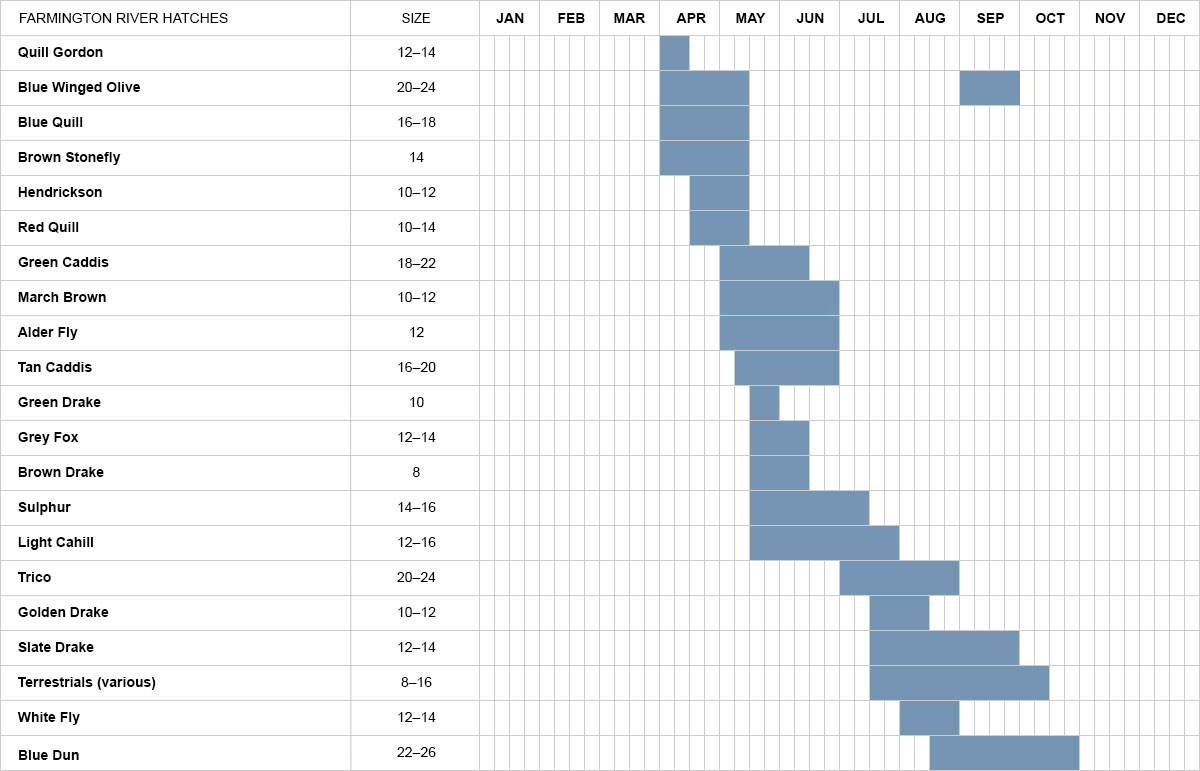Farmington River hatch chart listing the major fly hatches occurring along the Farmington River system in northcentral Connecticut. Hatch species, dates and emergence patterns may vary with annual changes in water flows and weather conditions.

Mayfly, stonefly and caddisfly flies go through three stages: Nymph (Larvae), Pupae/Emergence, and Adult. The hatch date reflects the transitional period from nymph to adult which may last from a few hours to a few days. Flies exist as nymphs subsurface prior to hatch date.
| Fly Hatch | Size | Date |
|---|---|---|
| Quill Gordon | 12 - 14 | Apr 1 - Apr 15 |
| Blue Winged Olive | 20 - 24 | Apr 1 - May 15; Sept 15 - Oct |
| Blue Quill | 16 - 18 | Apr 1 - May 15 |
| Brown Stonefly | 14 | Apr 1 - May 15 |
| Hendrickson | 10 - 12 | Apr 15 - May 15 |
| Red Quill | 10 - 14 | Apr 15 - May 15 |
| Green Caddis | 18 - 22 | May 1 - June 15 |
| March Brown | 10 - 12 | May 1 - June 30 |
| Alder Fly | 12 | May 1 - June 30 |
| Tan Caddis | 16 - 20 | May 10 - June 30 |
| Green Drake | 10 | May 15 - May 31 |
| Grey Fox | 12 - 14 | May 15 - June 15 |
| Brown Drake | 8 | May 15 - June 15 |
| Sulphur | 14 - 16 | May 15 - July 15 |
| Light Cahill | 12 - 16 | May 15 - July 31 |
| Trico | 20 - 24 | July 1 - Aug 31 |
| Golden Drake | 10 - 12 | July 15 - Aug 15 |
| Slate Drake | 12 - 14 | July 15 - Sep 30 |
| Terrestrials (various) | 8 - 16 | July 15 - Oct 15 |
| White Fly | 12 - 14 | Aug 1 - Aug 31 |
| Blue Dun | 22 - 26 | Aug 15 - Oct 31 |
Major Fly Hatches on the Farmington River
As with most trout streams, one of the most important aquatic insect and fly hatches on the Farmington River is the Blue-winged Olive. Blue-winged Olive hatches occur during early spring and then again in the fall.
Hendrickson and Red Quill mayflies are two more important hatches that begin in April and run through mid May. Having a few good nymph and adult fly imitations will serve you well when fishing the Farmington River in the spring.
For fishing sections of the Farmington with a fair amount of current, having a few March Brown and Light Cahill imitations is recommended. Amerian March Brown and Light Cahill hatches occur during late spring and summer where the water picks up speed—but these hatches tend to be sparse at best.
Caddisflies are one of the major food sources for trout throughout the summer months on the Farmington River, the cinnamon caddis being the most important caddis hatch of the season. Cinnamon caddis hatch from May through September. Tan and Green caddis, as well as Green sedges, are three more caddis hatches to consider. These later hatches occur during May and June.
Sulphurs during June, Little Black Caddis (Grammons) during April, and Tricos during July and August round out the noteworthy hatches on Farmington River.
Between June and October, terrestrials are on the scene. They make up a portion of trouts’ diet and should make up a portion of an angler’s fly selection. Beetles, ants, and grasshoppers are the patterns you want to have.
Midge hatches occur all season long and are probably the most important fly imitation to keep in your fly pouch. They always produce. A recommended fly size range for midge imitations is 18 to 24.
And.. if you’re interested in hooking some large browns, keep a few streamers on hand. We recommend sculpin patterns.



